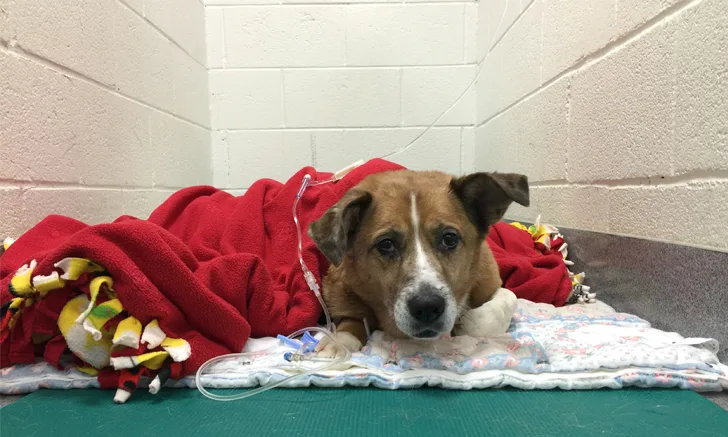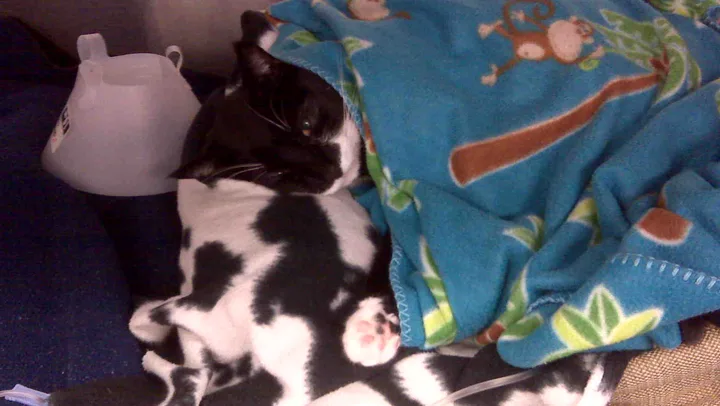Beyond Drugs: Providing Comfort & Care for Hospitalized Patients
Colleen R. Storrie, LVT, CCRP, The Oncology Service

Spending time in the practice can be frightening and uncomfortable for pets, and pain can increase the discomfort. Pharmaceutical agents are often administered to manage pain, but other modalities can provide relief, either alone or in conjunction with drug therapy.
Cage Bedding and Positioning
Appropriate cage bedding (eg, towels, blankets, carpet squares, yoga mats) is essential for patient comfort to provide padding and a nonslip surface. Additional bedding for geriatric and postoperative patients may also help prevent cage injuries.
Recumbent patients require more padding to prevent formation of decubitus ulcers, which are most likely to occur on bony prominences such as hips and elbows. (A good rule of thumb is 1 inch of padding for every 40 pounds.1) These patients should be repositioned at least every 4 hours with a focus on relieving pressure from areas at risk for ulceration.1
Passive Range of Motion Exercises
Patients with limited mobility should be given passive range of motion (PROM) exercises to help prevent joint contracture and soft-tissue adaptive shortening, reduce pain, and enhance blood, lymph, and synovial circulation. Support the bones proximal and distal to the joint, gently hold the limb close to the joint, and slowly move the distal limb through normal motion of the joint.2
Cryotherapy
Cryotherapy may be used in patients postoperatively or following trauma to provide analgesia and vasoconstriction, and to reduce inflammation, edema, and muscle spasm.3 Apply a nonadherent sterile pad or thin towel over the affected area and cover the pad or towel with a cold compress for 15 to 20 minutes. Cooling can penetrate approximately 4 cm deep if the area does not have other bandaging in place.4 If the cold compress is applied over thick bandaging or towels, penetration will be decreased.
Cryotherapy should be administered cautiously in patients with open wounds, fractures, sensory or motor nerve impairment, and hypertension, and in the very young and old.5 Assess for redness during and after application to ensure treatment safety.
Heat Therapy
Heat therapy can be used to prepare patients with chronic arthritis, spondylosis, or muscle, tendon or ligament tightness for exercise or massage.6 Heat therapy increases circulation through vasodilation, provides analgesia and relaxation of muscle spasm, and also helps increase soft-tissue compliance, so when the tissue is heated before stretching, the amount of stretch gained is maintained for a longer period of time.7 Heat applied superficially, such as a warm compress, can penetrate to approximately 2 cm deep and help relieve chronic joint pain and stiffness and promote reabsorption of edema and drainage from wounds and abscesses.7
Heat therapy should not be used for patients with infection and malignancy, and heat should not be applied to areas with signs of acute inflammation, including increased skin temperature, redness, and swelling. Heat therapy can be used cautiously in patients with decreased circulation, decreased or absent sensation, and hypotension8 but harmful effects like pain7 may occur if tissues are heated above 113°F.9

Therapeutic Laser
Therapeutic lasers, which deliver more power than low-level lasers, commonly called cold lasers, and less power than a surgical laser, are increasing in popularity.10 Laser therapy is commonly used in patients with chronic and acute edema to accelerate wound healing and treat arthritis and postoperative pain, and several neurologic conditions.11 Research on the biologic effects of therapeutic lasers is ongoing, but laser therapy has been shown to enhance wound healing and early bone repair, inhibit inflammation, and reduce pain.11 Laser therapy must be used with caution, or an alternative treatment considered, if certain conditions (eg, pregnancy, open fontanelles, growth plates in immature animals, malignancy, photosensitive skin areas) are present12 and should always be performed by a trained professional.
Massage Therapy
Massage therapy relieves stress, anxiety, and discomfort, increases venous and lymphatic return, and can effectively treat patients with pain.13 Some forms of massage that can be used include:
Stroking, which involves simply running a hand from neck to tail and provides an increase in the flow of blood and lymph
Effleurage, where fingers, thumbs, or the heel of the hand are used to make circular strokes over the area to be massaged, beginning distally and working toward a lymph node to reduce swelling and improve drainage
Percussion, most commonly known for its use in respiratory coupage but also used to stimulate local circulation, relax muscles, and provide general stimulation
Massage is contraindicated in patients in shock or with fever, acute inflammation, infection, tumors, skin problems such as ringworm, during acute stages of viral disease and cardiac decompensation.13,14
Music Therapy
Music has been used therapeutically for both veterinary and human medicine.15,16 Classical music has been shown to help relieve stress, anxiety, restlessness, and pain.15 In 2008, a sound researcher and a veterinary neurologist collaborated to produce Through a Dog’s Ear, an album containing classical piano arrangements clinically proven to reduce anxiety in dogs.17 A version for cats is now available, and other companies are now producing similar recordings.
Easy Listening to Help Animals
Music therapy should be implemented on an individual patient basis and the response evaluated to determine when and how often the music should be provided or whether it should be discontinued.
Conclusion
Veterinary team members strive to provide comfort and care to their hospitalized patients on a daily basis. Implementing these therapies can help decrease patient pain and anxiety.